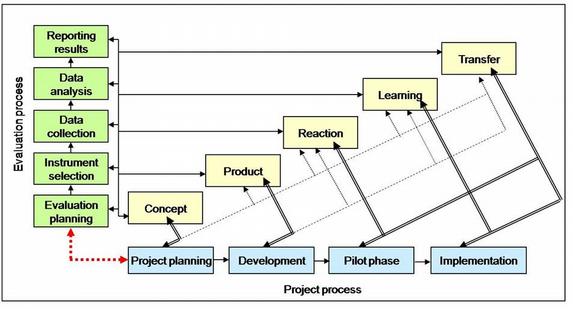|
|||||||||
Framework model
The framework model for project evaluation makes a distinction between three dimensions (cf. (Grund, Grote, & Windlinger, 2003; evaluationsnetz, 2005; Kirkpatrick, 1994; Schenkel, 2000):
- The evaluation process (green) describes the stages in evaluation from evaluation planning to communicating results.
- The project process (blue) breaks down the different phases of a project from planning to implementation.
- The evaluation levels (yellow) help you focus the question which the evaluation is to to answer.
The three dimensions are interrelated:
- Project process – evaluation levels (double arrows): In certain phases of the project, there may be different issues to evaluate. For example, at the end of the planning phase, the project design may be the focus of the evaluation, or in the pilot phase, the focus may be on student reactions and learning results. Dotted arrows mean that the planning of the evaluation can (or should!) be started in an early phase, even if it will relate to a 'higher' evaluation level. The arrows point in both directions to indicate that the results of the evaluation can be incorporated in the project process.
- Evaluation and project process sshould be coordinated (red arrow). Plan the evaluation early enough; do not wait until the end of the project as this allows an optimum coordination between the progress of the project and the evaluation or its results.
- Evaluation process – evaluation levels (single arrows): The phases of evaluation are always passed through, irrespective of which level(s) the evaluation relates to and when it is carried out during the course of the project. Here too, the arrows point in both directions: The results of an evaluation step can, in turn, be incorporated into the evaluation process.

